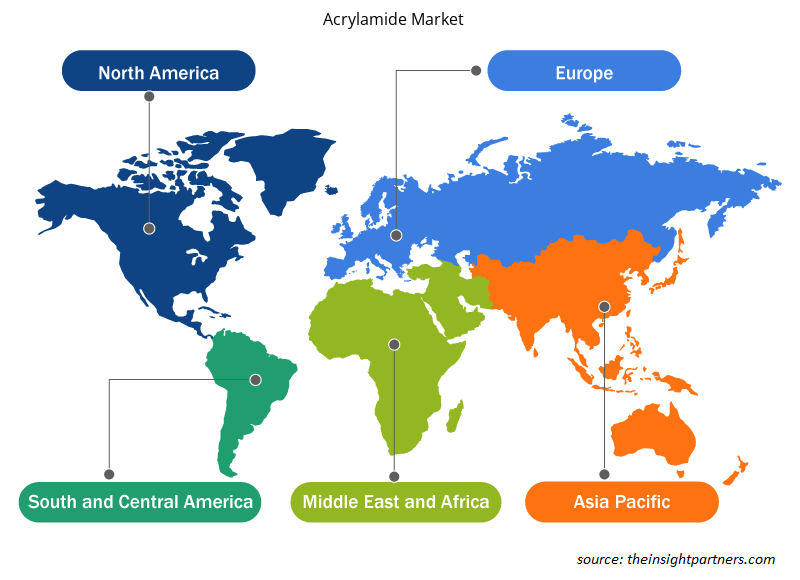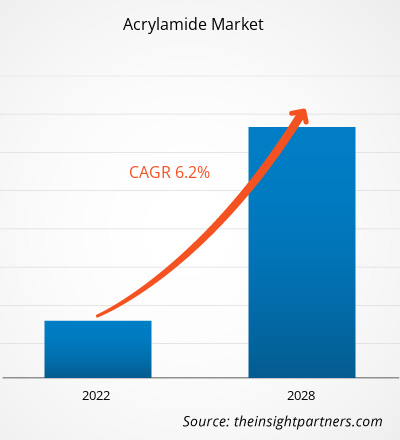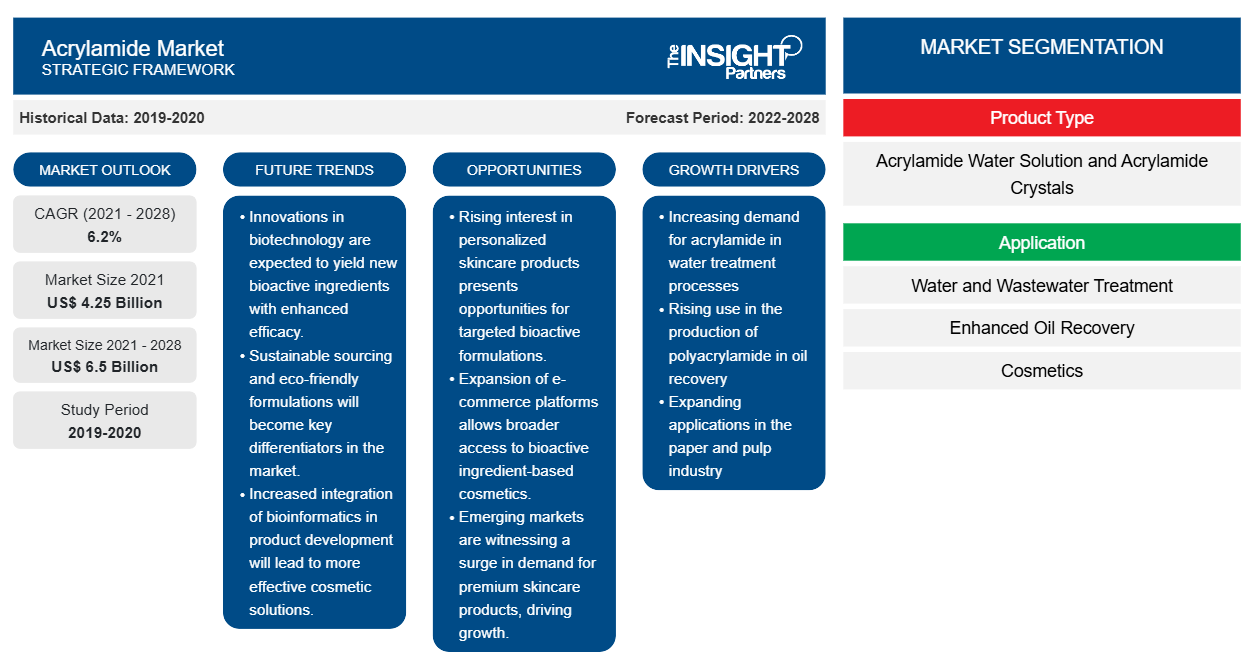Le marché de l'acrylamide devrait passer de 4 254,16 millions USD en 2021 à 6 500,22 millions USD en 2028 ; il devrait croître à un TCAC de 6,2 % de 2021 à 2028.
L'acrylamide est un produit chimique organique et inodore disponible sous forme liquide et cristalline. L'acrylamide est soluble dans l'eau et dans divers solvants organiques. C'est un précurseur des polyacrylamides qui ont plusieurs applications comme épaississants hydrosolubles et agents de floculation.
En 2020, l'Asie-Pacifique a dominé le marché mondial de l'acrylamide et devrait conserver sa domination au cours de la période de prévision. Le Japon et la Chine sont les principaux fabricants d'acrylamide, représentant une part importante de la capacité installée mondiale. Le soutien gouvernemental accru au traitement des eaux usées dans des pays comme l'Inde et la Chine, ainsi que la croissance de l'industrie des soins personnels et des cosmétiques dans la région stimulent la croissance du marché en Asie-Pacifique. L'industrie des soins personnels dans la région est en croissance en raison de l'augmentation de la population à revenu moyen, de l'augmentation du revenu par habitant, de l'amélioration du niveau de vie et de l'augmentation de la population active des femmes. Ainsi, la croissance de l'industrie des soins personnels a entraîné une augmentation de la demande d'acrylamide, car il est largement utilisé comme stabilisant, liant et épaississant dans les cosmétiques et les produits de soins personnels. Parallèlement à cela, l'Amérique du Nord devrait être la deuxième région à la croissance la plus rapide, ce qui est dû à l'augmentation des investissements dans le traitement des eaux usées ainsi qu'à une augmentation de la demande d'acrylamide du secteur de la récupération assistée du pétrole et des cosmétiques. L'Europe devrait également connaître une croissance considérable au cours de la période de prévision.
Personnalisez ce rapport en fonction de vos besoins
Vous bénéficierez d'une personnalisation gratuite de n'importe quel rapport, y compris de certaines parties de ce rapport, d'une analyse au niveau des pays, d'un pack de données Excel, ainsi que d'offres et de remises exceptionnelles pour les start-ups et les universités.
-
Obtenez les principales tendances clés du marché de ce rapport.Cet échantillon GRATUIT comprendra une analyse de données, allant des tendances du marché aux estimations et prévisions.
Informations sur le marché
Demande croissante en matière de traitement des eaux usées
La forte croissance économique, la croissance démographique et l'urbanisation rapide à travers le monde ont entraîné une augmentation de la consommation d'eau potable et de la production d'eaux usées. Plusieurs pays ont mis en place des normes strictes contre la pollution des masses d'eau et le rejet illégal d'eaux usées. Dans des pays comme la Chine, qui sont touchés par la pollution atmosphérique, des lois spéciales ont été mises en œuvre pour la protéger contre les effets nocifs du rejet des eaux usées. La gestion des eaux usées industrielles est devenue une préoccupation cruciale pour les organismes de réglementation, car les effluents industriels contiennent des produits chimiques nocifs, qui peuvent entraîner des risques pour la santé et nuire à la biodiversité marine. Ainsi, l'augmentation de la demande de traitement des eaux usées dans le monde entier stimule la croissance du marché.
Informations sur les types de produits
En fonction du type de produit, le marché est divisé en solutions aqueuses d'acrylamide et en cristaux d'acrylamide. En 2020, le segment des cristaux d'acrylamide était le segment qui connaissait la croissance la plus rapide sur le marché de l'acrylamide. Les cristaux d'acrylamide ont diverses applications et sont utilisés comme floculant, agent de blocage, agent de traitement des textiles et agent de traitement de l'eau.flocculant, blocking agent, textile treatment agent, and water treatment agent.
Ashland Global Holding Inc. ; SNF ; Kemira OYJ ; BASF SE ; EMCO Dyestuff ; Mitsui Chemicals Global, Pvt. Ltd. ; Ineos AG ; Solvay ; Nuoer Group ; et Black Rose Industries Ltd. ; comptent parmi les principaux acteurs opérant sur le marché mondial. Les principaux acteurs adoptent plusieurs stratégies, telles que les fusions et acquisitions et les lancements de produits, pour étendre leur présence géographique et leur base de consommateurs.
Aperçu régional du marché de l'acrylamide
Les tendances régionales et les facteurs influençant le marché de l’acrylamide tout au long de la période de prévision ont été expliqués en détail par les analystes d’Insight Partners. Cette section traite également des segments et de la géographie du marché de l’acrylamide en Amérique du Nord, en Europe, en Asie-Pacifique, au Moyen-Orient et en Afrique, ainsi qu’en Amérique du Sud et en Amérique centrale.

- Obtenez les données régionales spécifiques au marché de l'acrylamide
Portée du rapport sur le marché de l'acrylamide
| Attribut de rapport | Détails |
|---|---|
| Taille du marché en 2021 | 4,25 milliards de dollars américains |
| Taille du marché d'ici 2028 | 6,5 milliards de dollars américains |
| Taux de croissance annuel moyen mondial (2021-2028) | 6,2% |
| Données historiques | 2019-2020 |
| Période de prévision | 2022-2028 |
| Segments couverts |
Par type de produit
|
| Régions et pays couverts |
Amérique du Nord
|
| Leaders du marché et profils d'entreprises clés |
|
Densité des acteurs du marché de l'acrylamide : comprendre son impact sur la dynamique des entreprises
Le marché de l'acrylamide connaît une croissance rapide, tirée par la demande croissante des utilisateurs finaux en raison de facteurs tels que l'évolution des préférences des consommateurs, les avancées technologiques et une plus grande sensibilisation aux avantages du produit. À mesure que la demande augmente, les entreprises élargissent leurs offres, innovent pour répondre aux besoins des consommateurs et capitalisent sur les tendances émergentes, ce qui alimente davantage la croissance du marché.
La densité des acteurs du marché fait référence à la répartition des entreprises ou des sociétés opérant sur un marché ou un secteur particulier. Elle indique le nombre de concurrents (acteurs du marché) présents sur un marché donné par rapport à sa taille ou à sa valeur marchande totale.
Les principales entreprises opérant sur le marché de l'acrylamide sont :
- INEOS Styrolution India Limited
- Ashland Global Holdings Inc.
- SNF
- Kemira Oyj
- BASF SE
Avis de non-responsabilité : les sociétés répertoriées ci-dessus ne sont pas classées dans un ordre particulier.

- Obtenez un aperçu des principaux acteurs du marché de l'acrylamide
Rapports en vedette
- Tendances progressistes dans l'industrie de l'acrylamide pour aider les acteurs à développer des stratégies efficaces à long terme
- Stratégies de croissance commerciale adoptées par les entreprises pour assurer leur croissance sur les marchés développés et en développement
- Analyse quantitative du marché mondial de l'acrylamide de 2019 à 2028
- Estimation de la demande d'acrylamide dans diverses industries
- Analyse de Porters pour illustrer l'efficacité des acheteurs et des fournisseurs opérant dans l'industrie pour prédire la croissance du marché
- Développements récents pour comprendre le scénario concurrentiel du marché et la demande pour l'acrylamide
- Tendances et perspectives du marché associées aux facteurs qui stimulent et freinent la croissance du marché de l'acrylamide
- Compréhension des stratégies qui sous-tendent l'intérêt commercial concernant la croissance du marché mondial de l'acrylamide, aidant au processus de prise de décision
- Taille du marché de l'acrylamide à différents nœuds du marché
- Aperçu détaillé et segmentation du marché mondial de l'acrylamide ainsi que de sa dynamique industrielle
- Taille du marché de l'acrylamide dans diverses régions avec des opportunités de croissance prometteuses
L'analyse du marché mondial de l'acrylamide jusqu'en 2028 est une étude spécialisée et approfondie de l'industrie des produits chimiques et des matériaux, axée sur l'analyse des tendances du marché mondial de l'acrylamide. Le rapport vise à fournir un aperçu du marché avec une segmentation détaillée du marché. Le marché de l'acrylamide est segmenté en fonction du type de produit, de l'application et de la géographie. En fonction du type de produit, le marché est divisé en solution aqueuse d'acrylamide et en cristaux d'acrylamide. En fonction de l'application, le marché est segmenté en traitement de l'eau et des eaux usées, récupération assistée du pétrole , cosmétiques, fabrication de papier, intermédiaires chimiques, textiles et autres. En fonction de la géographie, le marché est segmenté en cinq régions principales : l'Amérique du Nord, l'Europe, l'Asie-Pacifique, le Moyen-Orient et l'Afrique, et l'Amérique du Sud et l'Amérique centrale. L'acrylamide est utilisé pour fabriquer un polymère d'acrylamide (polyacrylamide) qui est utilisé comme floculant dans le traitement des eaux usées. Il coagule la matière organique qui peut être éliminée par filtration. Le développement croissant des installations de traitement des eaux usées à travers le monde augmente la demande en acrylamide.
Profils d'entreprise
- Ashland Global Holding Inc.
- SNF
- Kemira OYJ
- BASF SE
- Colorants EMCO
- Mitsui Chemicals Global, Pvt. Ltd.
- Ineos AG
- Solvay
- Groupe Nuoer
- Industries de la Rose Noire Ltée;
- Analyse historique (2 ans), année de base, prévision (7 ans) avec TCAC
- Analyse PEST et SWOT
- Taille du marché Valeur / Volume - Mondial, Régional, Pays
- Industrie et paysage concurrentiel
- Ensemble de données Excel
Rapports récents
Témoignages
Raison d'acheter
- Prise de décision éclairée
- Compréhension de la dynamique du marché
- Analyse concurrentielle
- Connaissances clients
- Prévisions de marché
- Atténuation des risques
- Planification stratégique
- Justification des investissements
- Identification des marchés émergents
- Amélioration des stratégies marketing
- Amélioration de l'efficacité opérationnelle
- Alignement sur les tendances réglementaires























 Obtenez un échantillon gratuit pour - Marché de l'acrylamide
Obtenez un échantillon gratuit pour - Marché de l'acrylamide